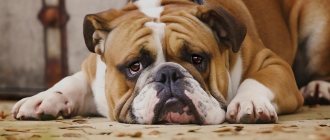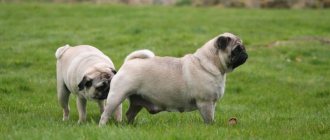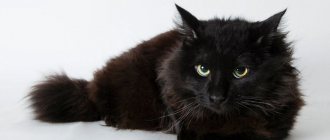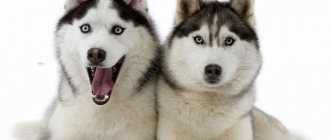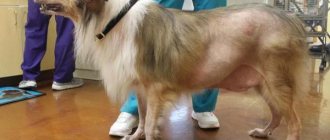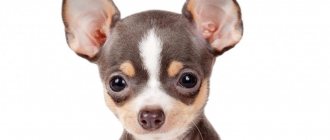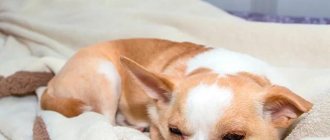The Chow Chow dog breed is known throughout the world and is easily recognizable due to its unusual blue tongue. In fact, the color of a Chow Chow's tongue can change throughout its life from deep black to purple. This depends on a variety of factors, such as the health of the dog, its mental state and even weather conditions.
In stressful situations or in hot weather, the tongue of these dogs becomes lighter.
Scientific background
For many years, scientists have been puzzling over the question of why the chow chow has a blue tongue, but they have not yet come to a consensus. However, several theories have been put forward that have a scientific basis:
- The ancestors of these dogs were polar wolves, which became extinct several thousand years ago, and also had a bright blue or purple tongue.
- China is officially considered the birthplace of this breed. Some canine scientists admit that these dogs were first bred in the Arctic. From there they moved to the territory of Siberia, then to Mongolia, and from Mongolia, together with nomadic traders, they moved to China. This version may well be true, because in harsh climates living creatures lack oxygen. They adapt to their surrounding conditions as best they can. Due to the constantly low oxygen content in the air in the body of the distant ancestors of modern Chow Chows, certain mutations occurred over time, which is why their tongues acquired a blue tint.
- Chow chows look very much like bears. That is why among scientists there are those who believe that these dogs are the result of crossing polar bears and Elkhounds or even Pomeranians. This version can be confirmed by the fact that polar bears also have blue or purple tongues.
The language of little chow chows
It is surprising that chow chow puppies are born with ordinary pink tongues. After about 20-30 days, the color of the tongue begins to gradually change. Every year the language becomes more vibrant.
REFERENCE! If you are planning to choose a Chow Chow puppy, be sure to pay attention to the color of its tongue. This usually happens in one and a half to two months. If at this time there are spots on the puppy's tongue or it is still not colored, it is better not to purchase such a puppy, most likely it is some kind of mixture. In addition, it is possible that this is not only a defect in the breed, but also some possible health problems.
Legends
There are many legends on this topic. For example, the most mysterious and beautiful of them says that the ancestors of these dogs became owners of blue tongues due to their courage.
Having created the earth and populated it with a variety of animals, God began to create the heavens. When he began to distribute the stars across the sky, one of the pieces of the sky broke off and fell to the ground. All the animals got scared and ran away. There was only one brave dog who came up and licked this fragment. This is how the tongues of these dogs acquired a blue tint.
Caring for puppies
The maintenance of a puppy and an adult dog is different. The baby needs to be kept safe by removing all wires and small objects. At first, the puppy cannot be taken outside, so the pet is taught to go to the toilet in a diaper.
Also, from an early age, a small pet must get used to hygiene procedures, a certain regime and rules established in the house.
A puppy is fed more often than an adult dog. The number of meals depends on the age of the dog:
- up to 8 weeks – 6 times a day;
- 2-4 months – 5 times a day;
- 4-6 months – 4 times a day;
- 6-10 months – 3 times a day;
- over 10 months – 2 times a day.
On a note. A sudden change in food can result in serious stress for the baby. Therefore, at first, the puppy food should be identical to that given by the breeder.
Other interesting features of the breed
In addition to the blue tongue, the Chow Chow has several other features:
- These dogs come in both short-haired (smooth) and long-haired.
- Their fur has a special structure. It is not prone to tangles, hardly gets dirty and is capable of self-cleaning.
- These dogs have a very unusual gait. Straight limbs force them to move in short steps, like on stilts.
- Chow chows are prone to developing allergies, so their diet needs to be monitored very carefully.
- These dogs are very silent and will never bark just like that.
Chow-chow owners can be proud that they have become the proud owners of one of the most unusual dog breeds in the world, because the blue color of the tongue makes these dogs truly unique.
Chihuahua appearance
Chihuahua puppy
The appearance of modern Chihuahuas is partly a legacy of the ancient Techichi, partly the product of many years of experiments in mating animals with representatives of other breeds. For example, in the blood of today's Chihuahuas you can find the genes of Toy Terriers, Spitz, Papillons and Pinschers.
Head
The skull is round, shaped like an apple. Individuals without a fontanel are considered standard, but for animals of the pet category, the presence of a small non-ossified area of the skull is allowed. The muzzle is wide and short, gradually tapering towards the nose. When viewed from the side, it is straight. The transition from the forehead to the muzzle is quite wide and clearly expressed. The cheeks are flat and dry, fitting tightly to the skull.
Jaws and teeth
The Chihuahua's bite is straight and scissor-shaped. The optimal number of teeth is 4 canines, 12 incisors, 10 molars and 16 premolars.
Nose
Short, looks up a little. The color of the lobe can be black, or to match the main color of the animal, although in the case of show-class individuals, preference is given to the first option.
Eyes
Round, large, but without convexity. The ideal shade of the iris is dark. Light eyes are not disqualifying for a Chihuahua, although they are undesirable.
Ears
Erect, wide at the base, with a softly rounded tip. A dog in a calm state has its legs “spread” in different directions and hangs at an angle of 45°.
Medium length, with a slight bend at the top. Males have a more massive neck.
Chihuahua muzzle
Frame
Compact, with a short back and muscular loin. The topline is level. The croup is wide, strong, without a noticeable slope. The chest is of sufficient width and moderately deep. The abdominal muscles are well toned. An insufficiently toned stomach is not desirable.
Limbs
Chiuhahua
The Chihuahua's front legs are long and straight. Shoulders are muscular and dry. Elbows are strong, pressed to the body. The pasterns are flexible, strong, and set at a slight angle. The muscles of the hind legs are developed, the posture is correct and even. The limbs are parallel. The paws are small in size, with splayed toes. The pads are developed and springy. The claws are moderately long and arched.
Tail
The Chihuahua's tail is medium in size, set high, thick at the base and gradually tapering towards the tip. In purebred individuals, the bend of the tail has the shape of a crescent, and its tip “looks” towards the lumbar region.
Wool
Based on the type of coat, Chihuahuas are divided into long-haired and short-haired. The former have a soft, silky coat with a smooth or slightly wavy structure with a small amount of undercoat. The longest guard hair grows in the neck, ears, paws, and back of the limbs.
In short-haired individuals, the awn is smooth and short, lying tightly to the body. The fur is longer in the neck and tail areas, the shortest is on the head and ears.
Defects in appearance and disqualifying defects
chiuhahua tail
Deviations from the standard can be either minor or serious. The most common faults in a Chihuahua's appearance are pointed ears, a curled or short tail, a long body and a short neck. Sloping croup, narrow chest, short or closely spaced limbs are not welcome. Serious deviations from the norm include a narrow skull, too long muzzle, deep-set or, conversely, excessively bulging eyeballs, patellar luxation, and malocclusion.
The main disqualifying faults of a Chihuahua:
- open fontanelle of the skull;
- behavioral deviations (cowardice, aggression);
- absence of a tail;
- short or cropped ears;
- excessively long body;
- alopecia in short-haired individuals (baldness);
- guard hairs that are too long and fluttering (in long-haired animals);
- “deer” silhouette (small head with elongated neck and legs);
- weight less than 500 g and more than 3 kg.
Treatment of heart diseases
If a dog has a blue tongue, what should you do in this case? It is important to have the animal checked by a veterinarian for pathologies of the cardiovascular system. What diseases can be detected? How to treat them?
Cardiomyopathy, unfortunately, cannot be completely cured. However, you can improve your pet’s well-being with the following medications: the diuretic Triampur and the heart medicine Digoxin. Myocardial infarction is treated with the following drugs - to maintain the activity of the heart "Digoxin", "Prazosin", for edema "Lasix", "Eufillin" and "Quinidine sulfate" for arrhythmia. Myocarditis requires the following therapy - injections of Sulfocamphocaine, as well as antibiotics to treat the primary focus of the disease. In case of chronic heart failure, medications are needed to maintain the functioning of the heart muscle in a normal rhythm.
In addition, it is important to adhere to a salt-free diet and nutrition regimen. If your dog is overweight, it is necessary to consult a veterinarian for further weight loss, since obese animals significantly increase the load on the cardiovascular system.
Answer
Tracheal collapse is considered a genetic disorder in Toy Terriers suffering from chronic degenerative anatomical deformity of the tracheal rings. The process occurs due to compaction, and the lumen becomes crescent-shaped. As a result, the lower and upper walls of the trachea rub against each other, the dogs begin to cough, choke, and experience suffocation. Often, without timely help, death occurs.
A veterinarian is able to diagnose the disease; it is necessary to show the animal to the doctor, knowing about the predisposition to the disease. The doctor, using the palpation method, if no clinical symptoms are observed, will examine the trachea and its shape on the toy terrier’s neck. The first sign of tracheal collapse is a thickening on the upper wall of the trachea or the formation of a groove located at the junction of the trachea and the chest. The doctor will prescribe a clinical examination, in particular endoscopy and x-rays. Endoscopy helps determine the stage of development of collapse, illuminating the direction of treatment.
The most common causes of cyanosis in dogs
Pulmonary edema
Pneumothorax and hydrothorax
Most often it occurs as a result of injuries in the chest area, falls from a height, car injuries, and bites. Pneumothorax is an accumulation of air in the chest cavity, hydrothorax is an accumulation of fluid. In these conditions, the lungs are unable to fill with air normally, and in some cases, part or one entire lung does not work.
To confirm this diagnosis, the doctor will need to take x-rays.
Typically, fluid or air is removed from the chest cavity. The procedure is not complicated and is usually performed under sedation (a small dose of a sedative). It is also necessary to identify the cause of this condition. This may require testing of fluid removed from the chest cavity. Further treatment will be aimed at preventing the onset of symptoms and treating the disease that caused them; in severe cases, surgery is required.
Hypertrophy of the velum
Most often found in dogs is the so-called. brachiocephalic breeds (boxers, pugs, bulldogs, Pekingese, etc.). With this pathology, the lumen of the larynx is closed by enlarged tissue of the soft palate, thereby limiting the flow of air into the lungs.
Most often, symptoms appear when the animal is excited (joy, stress, pain) and is accompanied by attacks of shortness of breath, up to “respiratory” fainting. Also, such symptoms may increase in these breeds when it is hot.
If, upon admission of such an animal to the clinic, its condition is assessed as critical, then the animal is placed in the intensive care unit, where doctors can resume the normal flow of air into the lungs: install a tracheal tube, connect the dog to a ventilator. Often in this case, surgery is indicated - plastic surgery of an enlarged velum and tracheotomy (surgical creation of an opening in the trachea in the neck, bypassing the oral cavity). This hole will be temporary until the dog resumes normal breathing after surgery. Then the hole will gradually close on its own. In rare cases, a dog needs a tracheostomy for life.
Collapse (narrowing) of the trachea
This problem is most common in dogs of small and toy breeds: Yorkshire Terrier, Shih Tzu, Miniature Poodle, Toy Terrier, etc. The diagnosis is made on the basis of tracheoscopy - a special examination of the trachea from the inside under general anesthesia. A doctor may suspect the presence of this disease if there is a visible narrowing of the trachea on an X-ray of the patient.
Congenital heart defects
Owners notice persistent cyanosis in their pets at an early age. The so-called “blue” (causing cyanosis) defects include:
- atrial septal defect,
- ventricular septal defect,
- a combined defect called tetralogy of Fallot.
The incidence of these congenital heart defects in dogs accounts for a very small percentage. To make such a diagnosis, it will be necessary to undergo a full cardiac examination: ECG (electrocardiography), ECHO (ultrasound of the heart) and chest x-ray.
Treatment of pulmonary diseases
Why and why a dog has a blue tongue is described above. How to cope with diseases of the respiratory system that can cause such a pathological condition?
For respiratory diseases and rhinitis that make it difficult for the animal to breathe, the following treatment is used - the antibiotic Ampicillin, the antiallergic drug Suprastin and nasal drops Anandin. For laryngitis (inflammation of the larynx), medications such as Prednisolone and Suprastin are used; the larynx must be lubricated with Lugol's solution or sprayed with Ingalipt. Bronchitis is treated with the following medications - Ampicillin, Prednisolone, Suprastin, Bromhexine, Eufillin, Mucaltin. For pneumonia (pneumonia), the following treatment is effective: antibiotics Cefazolin, Gentamicin, intravenous infusion of Furosemide solution to prevent pulmonary edema, drugs to maintain cardiac function (Digoxin, Cordiamin). Pleurisy (inflammation of the pulmonary membrane) requires the following therapy - antibiotics "Cefazolin", "Gentamicin", painkillers "No-shpa", "Baralgin", expectorants, diuretics. If there is a large accumulation of fluid, it must be removed surgically.
The need to use a particular drug, as well as the dosage (based on the dog’s weight), can only be prescribed by a qualified veterinarian; self-medication can be dangerous to the pet’s health.
